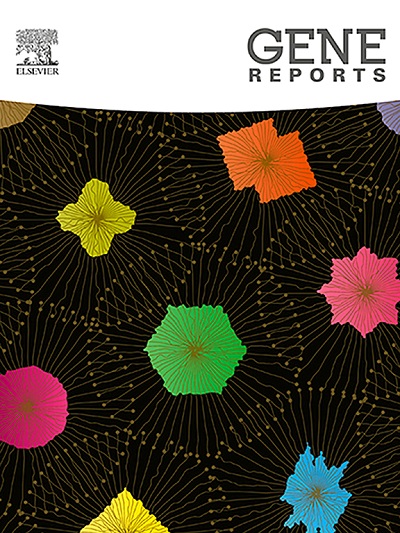Azoospermia factor gene microdeletions in infertile men with non-obstructive azoospermia and normal karyotype: First case-control study from Kashmir
IF 1
Q4 GENETICS & HEREDITY
引用次数: 0
Abstract
Background
Micro-deletions in the Y chromosome are recognized as the causative factor for male infertility. The prevalence of Y chromosome micro-deletions exhibits variation among infertile males across different areas and races globally. The study of Y chromosome micro- deletions is crucial among genetic variables owing to their ability to transmit genetic defects to the progeny. Microdeletion of the azoospermia factor (AZF) region associated with the long arm of the Y chromosome (Yq) has three sub-regions (AZFa, AZFb, and AZFc) that play an important role in spermatogenesis. The genes associated with the AZF region of the Y chromosome are believed to play a crucial role in the process of spermatogenesis by performing several activities such as gene silencing, transcription, ubiquitination, and maintenance of microtubule networks. Due to the absence of epidemiological research on Y chromosome micro-deletions in ethnic infertile male population of Kashmir, our study sought to examine the Y chromosome micro-deletions among non-obstructive azospermic infertile men in Kashmir.
Objective
The research was aimed to establish the frequency and characteristics of micro-deletions in the AZF region of Y chromosome in infertile males of our population with non-obstructive Azoospermia and normal Karyotype.
Methods
A total of 120 subjects were included in the study. Samples from 60 male patients with fertility issues (non-obstructive azoospermia) and an equal number of samples from normal men having established fatherhood (biological fathers) were taken for the study. The average age in years of cases and controls were 32.80 and 34.88 respectively. A total of 26.66 % of cases and 13.33 % of controls were found to be consanguineous, 36.66 % of cases and 40 % of controls were urban while 63.33 % of cases and 60 % of controls were from rural population. Molecular analysis was performed by multiplex polymerase chain reactions (PCR) using sequence tagged sites (STS) from 3 different regions of AZF of Y chromosome. To assess the frequency of AZF micro-deletions, molecular analysis was performed by multiplex polymerase chain reactions (PCR) using sequence tagged sites (STS) from 3 different regions of the Y chromosome (sY84 and sY86 for AZFa region; sY127 and sY134 for AZFb; sY254 and sY255 for AZFc region).
Results
In the present study a total of 9 out of 60 cases (15 %) were found to have Y chromosome micro- deletions in AZF region of Yq arm. The most frequent micro deletions were observed in AZFb region, 8 out of 60 cases (13.33 %) from AZFb region were found to have deletions.5 out of 60 cases (8.33 %) were reported with deletions associated to AZFc region region and 6.66 % of cases were found to harbor deletions in both AZFb and AZFc region. However no deletion was reported in the AZFa region in all the studied cases. No micro-deletions were reported in the controls during the study.
Conclusion
The study represents the first report on the incidence of Y chromosome microdeletions in infertile men from our population. The findings from the present study indicate the prevalence of these gene microdeletions as a major contributing factor to the etiology of infertility in males. This study emphasizes that the multiplex PCR based screening is a reliable method in ruling Y chromosome micro deletions as a factor in the pathogenicity of male infertility and recommends genetic testing prior to planning of any reproductive assistance.
患有非梗阻性无精子症且核型正常的不育男性中的无精子症因子基因微缺失:来自克什米尔的首个病例对照研究
背景Y染色体微缺失被认为是男性不育症的致病因素。在全球不同地区和种族的不育男性中,Y 染色体微缺失的发生率存在差异。由于 Y 染色体微缺失能够将遗传缺陷传递给后代,因此对 Y 染色体微缺失的研究在遗传变异中至关重要。与 Y 染色体(Yq)长臂相关的无精子症因子(AZF)微缺失区有三个亚区(AZFa、AZFb 和 AZFc),它们在精子发生过程中发挥着重要作用。据信,与 Y 染色体 AZF 区相关的基因在精子发生过程中发挥着至关重要的作用,可进行基因沉默、转录、泛素化和维持微管网络等多种活动。由于缺乏对克什米尔不育男性人群中 Y 染色体微缺失的流行病学研究,我们的研究试图检测克什米尔非阻塞性无精子症不育男性中的 Y 染色体微缺失情况。研究旨在确定我国非梗阻性无精子症且核型正常的不育男性中 Y 染色体 AZF 区微缺失的频率和特征。研究从 60 名有生育问题的男性患者(非梗阻性无精子症)和同等数量的已为人父的正常男性(生父)中抽取样本。病例和对照组的平均年龄分别为 32.80 岁和 34.88 岁。共发现 26.66% 的病例和 13.33% 的对照组为近亲结婚,36.66% 的病例和 40% 的对照组为城市人口,而 63.33% 的病例和 60% 的对照组为农村人口。利用 Y 染色体 AZF 的 3 个不同区域的序列标记位点 (STS) 进行多重聚合酶链反应 (PCR) 进行分子分析。为评估AZF微缺失的频率,使用Y染色体3个不同区域的序列标记位点(STS)(AZFa区域为sY84和sY86;AZFb区域为sY127和sY134;AZFc区域为sY254和sY255)进行多重聚合酶链式反应(PCR)进行分子分析。在 60 个病例中,有 5 个病例(8.33%)被报告与 AZFc 区域的缺失有关,有 6.66% 的病例被发现在 AZFb 和 AZFc 区域均存在缺失。然而,在所有研究病例中,均未发现 AZFa 区的缺失。本研究首次报道了我国人群中不育男性的 Y 染色体微缺失发生率。本研究的结果表明,这些基因微缺失是导致男性不育的一个主要因素。本研究强调,基于多重 PCR 的筛查是排除 Y 染色体微缺失作为男性不育致病因素的可靠方法,并建议在计划任何生殖援助之前进行基因检测。
本文章由计算机程序翻译,如有差异,请以英文原文为准。
求助全文
约1分钟内获得全文
求助全文
来源期刊

Gene Reports
Biochemistry, Genetics and Molecular Biology-Genetics
CiteScore
3.30
自引率
7.70%
发文量
246
审稿时长
49 days
期刊介绍:
Gene Reports publishes papers that focus on the regulation, expression, function and evolution of genes in all biological contexts, including all prokaryotic and eukaryotic organisms, as well as viruses. Gene Reports strives to be a very diverse journal and topics in all fields will be considered for publication. Although not limited to the following, some general topics include: DNA Organization, Replication & Evolution -Focus on genomic DNA (chromosomal organization, comparative genomics, DNA replication, DNA repair, mobile DNA, mitochondrial DNA, chloroplast DNA). Expression & Function - Focus on functional RNAs (microRNAs, tRNAs, rRNAs, mRNA splicing, alternative polyadenylation) Regulation - Focus on processes that mediate gene-read out (epigenetics, chromatin, histone code, transcription, translation, protein degradation). Cell Signaling - Focus on mechanisms that control information flow into the nucleus to control gene expression (kinase and phosphatase pathways controlled by extra-cellular ligands, Wnt, Notch, TGFbeta/BMPs, FGFs, IGFs etc.) Profiling of gene expression and genetic variation - Focus on high throughput approaches (e.g., DeepSeq, ChIP-Seq, Affymetrix microarrays, proteomics) that define gene regulatory circuitry, molecular pathways and protein/protein networks. Genetics - Focus on development in model organisms (e.g., mouse, frog, fruit fly, worm), human genetic variation, population genetics, as well as agricultural and veterinary genetics. Molecular Pathology & Regenerative Medicine - Focus on the deregulation of molecular processes in human diseases and mechanisms supporting regeneration of tissues through pluripotent or multipotent stem cells.
 求助内容:
求助内容: 应助结果提醒方式:
应助结果提醒方式:


